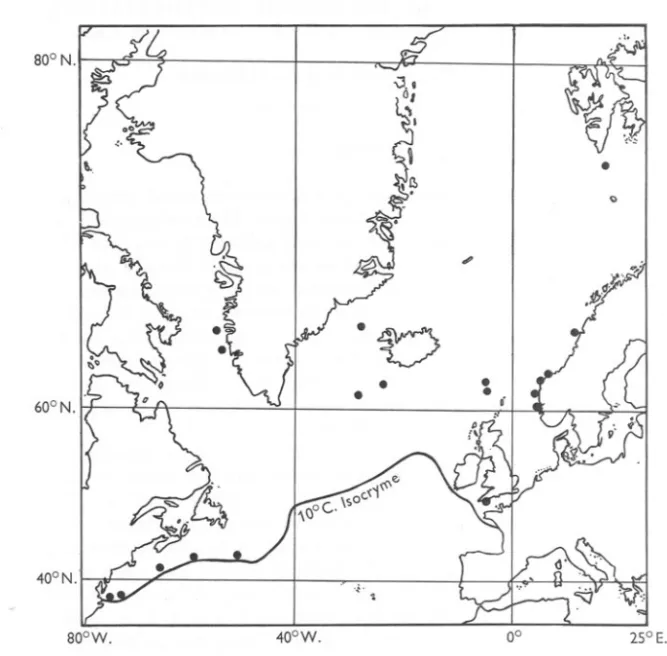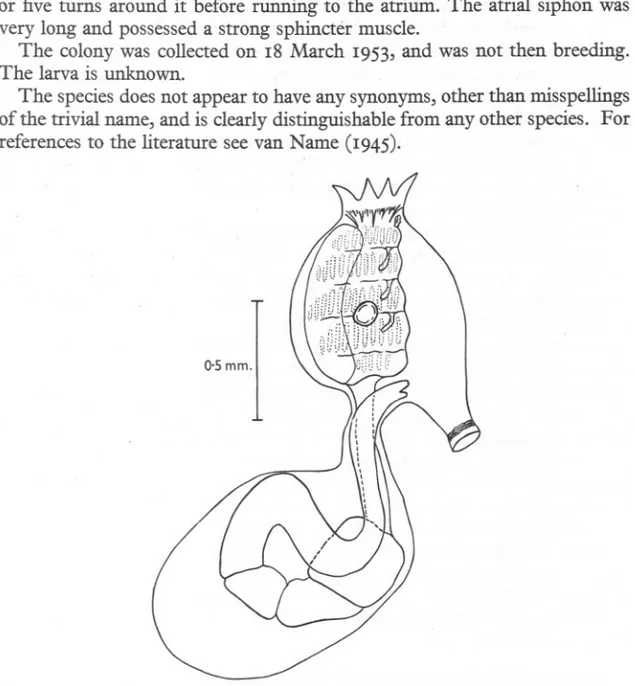Notes on the Didemnidae (Ascidiacea). I. The presence of Didemnum (Leptoclinides) faeroense (Bjerkan) in the Plymouth area
Full text
(2) D. B. CARLISLE. 22. AND. A. 1.CARLISLE. number was only 3-5. There were usually three dorsallanguets; a fourth was occasionally present if there was a fifth row of stigmata, though not always even then. The lateral thoracic organ was small, a little less than the height of a single row of stigmata, and lay between the third and fourth rows.. BOON.. . <>. ,. 600N.. 400N. BOOW.. .,. 4QOW.. 0°. 25°E.. Fig. I. The recorded distribution of D. (Leptoclinides)faeroense,showing agreement between the most southerly records of the species and the mid-winter sea temperature of 10° C.. The abdomen was little, if at all, larger than the thorax. The neck was sharply constricted. The oesophaguswas straight and opened into a globular or squarish stomach.The post-stomachwas horizontal and formed the bottom of the gut loop. The mid-intestine was short and sharply delimited from the post-stomach and from the rectum by grooves.The rectum was curved into an abrupt S; the final bend lay to the left of the stomach. The ovary lay entirely within the intestinal loop, the testis to the left side of the loop extending rather behind the mid-intestine. It was undivided. The sperm duct made four.
(3) DIDEMNUM. FAEROENSE. IN THE. PLYMOUTH. AREA. 23. . or five turns around it before running to the atrium. The atrial siphon was very long and possessed a strong sphincter muscle. The colony was collected on 18 March 1953, and was not then breeding. The larva is unknown. The speciesdoes not appear to have any synonyms, other than misspellings of the trivial name, and is clearly distinguishablefrom any other species. For references to the literature see van Name (1945).. O'5mm.. Fig. 2. Drawing from the left side of a large zooid of D. faer6ense,omitting the reproductive system. Note especially the incipient fifth row of stigmata only present in the largest zooids.. Six species of the genus Leptoclinidesare known, the north Atlantic L. faeroensis,the south Atlantic L. brasiliensis,known only from Michaelsen's (1923) description of his type specimen, L. glauerti Michaelsen (1930), likewise known only from the type specimen, L. dubius(Sluiter), L. ocellatus (Sluiter), and L. madara Tokioka. The last three of these species are not significantly different, except in the condition of the atrial system, from the subgenus Polysyncraton of Didemnum. Sluiter's species were indeed described under this genus, but they were separated from it by Michaelsen (1930) and Tokioka (1953). Leptoclinidesmadara, according to its author,.
(4) 24. . D. B. CARLISLE. AND. A. 1. CARLISLE. may be merely a colour variant of L. ocellatus. L. brasiliensisis rather similar. to L. faeroensis, but has an unlobed branchial siphon, and the common cloacal cavity is completely below the level of the zooids so that the atrial siphon is even more prolonged. Michaelsen suggeststhat the common cloacal cavity may open on the lower side of the colony, but this cannot happen in L. faeroensisbecause the whole lower surface is attached to the substratum. In L. glauerti the atrial siphons open direct on to the lower surface of the colony and the common cloacal cavity system is abolished altogether, or represented at most by small local depressions on the lower side into which individual atrial siphons open. .. If, then, the more posterior level of the common cloacal system is worthy of generic distinction, how much more should be the complete abolition of the system. If, in other words, the genus Leptoclinides has any validity as separate from Didemnum, then Leptoclinides glauerti should be in a further separate genus. But how valid is the genus Leptoclinides? L. faeroensis, the type of the genus, differs from Didemnum only in the position of the common cloacal cavity and in the associated prolongation of the atrial siphon. The same condition is seen to a lesser extent in Trididemnum tenerum and T. niveum (see Carlisle, 1953), yet there is no suggestion that the condition is worthy of generic distinction there. Within both Didemnum and Trididemnum there is great specific and individual variation in the degree of development, the extent and the level of the common cloacal system, and it is for this reason that the genus Leptoclinum has been abandoned-the character on which it is based is too variable. Now it is on precisely this character that the genus Leptoclinides is based. The distinction does not hold so the genus collapses. L. faeroensis and L. brasiliensis should be received into the genus Didemnum, retaining subgeneric rank, while L. glauerti requires a new genus for its reception. The name Sinecloaca seems appropriate as expressing the lack of common cloacal cavity in this form. Sinecloaca n.gen.: an ascidian genus presenting typical didemnid characters possessing usually four rows of stigmata; sperm duct coiled around testis; differing from Didemnum Savigny in the reduction, apparently secondary, of the common cloacal cavity system to a few local depressions on the lower surface of the colony into which individual atrial siphons open direct to the sea, and in the corresponding elongation of the atrial siphons to open in this manner on the side of the colony opposite to the branchial siphons. Type species: Sinecloaca glauerti (Michaelsen) (= Leptoclinides glauerti Michaelsen, 1930). The remaining species of the abandoned genus Leptoclinides Bjerkan become Didemnum (Leptoclinides) faerO"ense (Bjerkan) and D. (Leptoclinides) brasiliense (Michaelsen), while L. dubius, L. ocellatus, and L. madara go back to Polysyncraton where they belong-Didemnum (Polysyncraton) dubius (Sluiter), D. (P.) ocellatus (Sluiter), and D. (P.) madara (Tokioka) or D. (P.) ocellatus (Sluiter) forma madara (Tokioka).. f.
(5) DIDEMNUM. FAEROENSE. IN THE. PLYMOUTH. AREA. 25. SUMMARY. Didemnum(Leptoclinides)faerOense Bjerkanis present in Plymouth waters. The adult is briefly described. The genus LeptoclinidesBjerkanis not valid and two of its six species should be included in Didemnum as a separate subgenus, a third species, L. glauerti, must remain separate in a genus of its own for which the name Sinecloacan.gen. is pr-oposed,while the remaining three species are returned to the subgenus Polysyncraton. REFERENCES BJERKAN,P., 19°5. Ascidien von dem norwegischen Fischereidampfer 'Michael Sars' in den Jahren 19°0-1904 gesammelt. Bergens Mus. Aarb., 19°5, NO.5, pp. I-3°. CARLISLE,D. B., 1953. Notes on the British species of Trididemnum (Didemnidae, Ascidiacea), with a report on the occurrence of T. niveum (Giard) in the Plymouth area. J. Mar. biol. Ass. U.K., Vol. 31, pp. 439-45. MICHAELSEN, W., 1923. Neue und altbekannte Ascidien aus dem Reichsmuseum zu Stockholm. Mitt. zool. Mus. Hamb., 1923, pp. I-6o. 193°. Die Fauna Stidwest-Australiens: Ascidiae Krikobranchiae. Ergebnisse der Hamburger sudwest-australischen Forschungsreise (1905), Bd. 5, pp. 463-558. SLUITER,C. P. 1909. Die Tunicaten der Siboga-Expedition. II. Die merosomen Ascidien. Siboga Exped., Bd. 56 b. TOKIOKA,T. 1953. Ascidians of Sagami Bay. 315 pp. Tokyo. VANNAME, W. G., 1945. The North and South American ascidians. Bull. Amer. Mus. nat. Hist., Vol. 84, pp. 1-476..
(6)
Figure


Related documents
Hot citrate extracts were prepared from cultures of most of the fungal species listed in Table 4, including the chytridiomycete Batrachochytrium dendrobatidis , two FIG 3 Effect
But that is Marx’s exact point in discussing the lower phase of communism: “Right can never be higher than the economic structure of society and its cultural development which
We begin by briefly describing the predictors of wanting to stop having children; proceed to assess the association between married rural women’s desires to stop childbearing
If he randomly chooses a student to do a problem in the front of the class, what is the probability that he chooses a girl given he needs it to be a
In this study it was observed that the number of patients who fell in the severe parasitemia group had a higher incidence of alteration of coagulation profile more
rootstock was greater than the Pixy and Miroval rootstocks refering to chlorophyll a/b ratio in the phenophases: intense growth of shoots (CIL) and the slowing
Besides described parametars, the other parameters of quality of the Hilandar grape and wine are also known from previous investigations and they are reflected
Détection de changement sur des données géométriques